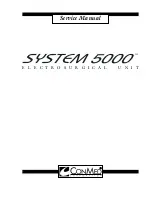
3-3
to optimize the electrosurgical output waveform.
Finally, the RF Controller minimizes RF leakage
currents using the CONMED Leakage Abatement
System (CLAS™), which imposes a duty cycle on
the electrosurgical output when sensed impedance
and output voltage exceed settings-based imped-
ance thresholds and voltage limits in the Coag
modes.
The RF Monitor is also a DSP, but it is used to
monitor the system for a variety of conditions that
could lead to safety problems, including:
• The Monitor has independent sensors for out
-
put voltage and current, which it uses to cal-
culate power for comparison with the power
that the RF Controller senses and for com-
parison with the generator power setting.
• To ensure that the correct outputs are acti
-
vated, the Monitor also independently
senses current at each of the outputs, look-
ing for current flow that would indicate
electrosurgical power at outputs other than
the selected output.
• The Monitor senses the voltage at the output
of the HVPS to ensure that it is reasonable
for the power setting.
• The Monitor senses the audio output to ensure
that a tone occurs whenever electrosurgical
outputs are active.
• The RF Amplifier drive signal is sensed by
the Monitor to detect improper frequencies
or improper pulse sequences for the selected
mode.
• The Monitor independently compares the
activation signal with that seen by the System
Controller to ensure that the activation signal
is consistent.
The Monitor has the capability to independently
disable the electrosurgical output if a problem is
detected.
The System Controller provides the primary con-
trol interface to the user and other outside sys-
tems, including the serial interface, the activation
relay, tone generation, and displays.
Finally, the Display accepts all user input and pro-
vides all user feedback. The Display is controlled
by the System Controller through a serial interface
and illuminates the LED display elements in a
time division multiplexed fashion; the illuminated
LED display elements are actually on less than half
the time. The Display also provides for user input
through the buttons on the control panel, includ-
ing switch de-bouncing and conditioning.
Figure 3.2 illustrates the key elements of the sys-
tem in block diagram form.
3.2.1 High Voltage Power Supply (HVPS)
The HVPS is comprised of a Power Factor
Control (PFC) section and a Forward Converter
(FC) section. The PFC converts Mains power
to approximately 400 volts using techniques
that ensure the mains current into the supply is
sinusoidal and in phase with the mains voltage.
By doing so, RMS current and harmonic distor-
tion are reduced. The Forward Converter then
Voltage
sampled
450,000
times per
second
Current
sampled
450,000
times per
second
Power
setting –
watts
displayed
on the front
panel
Calculate
measured
resistance
Calculate
measured
power
Compare
Desired
Power
Measured
Power
Adjust
output
waveform
(power)
Patient
0
20
40
60
80
100
120
140
160
180
200
0
500
1000
1500
2000
90
35
180
Figure 3.1 RF Controller Block Diagram






















